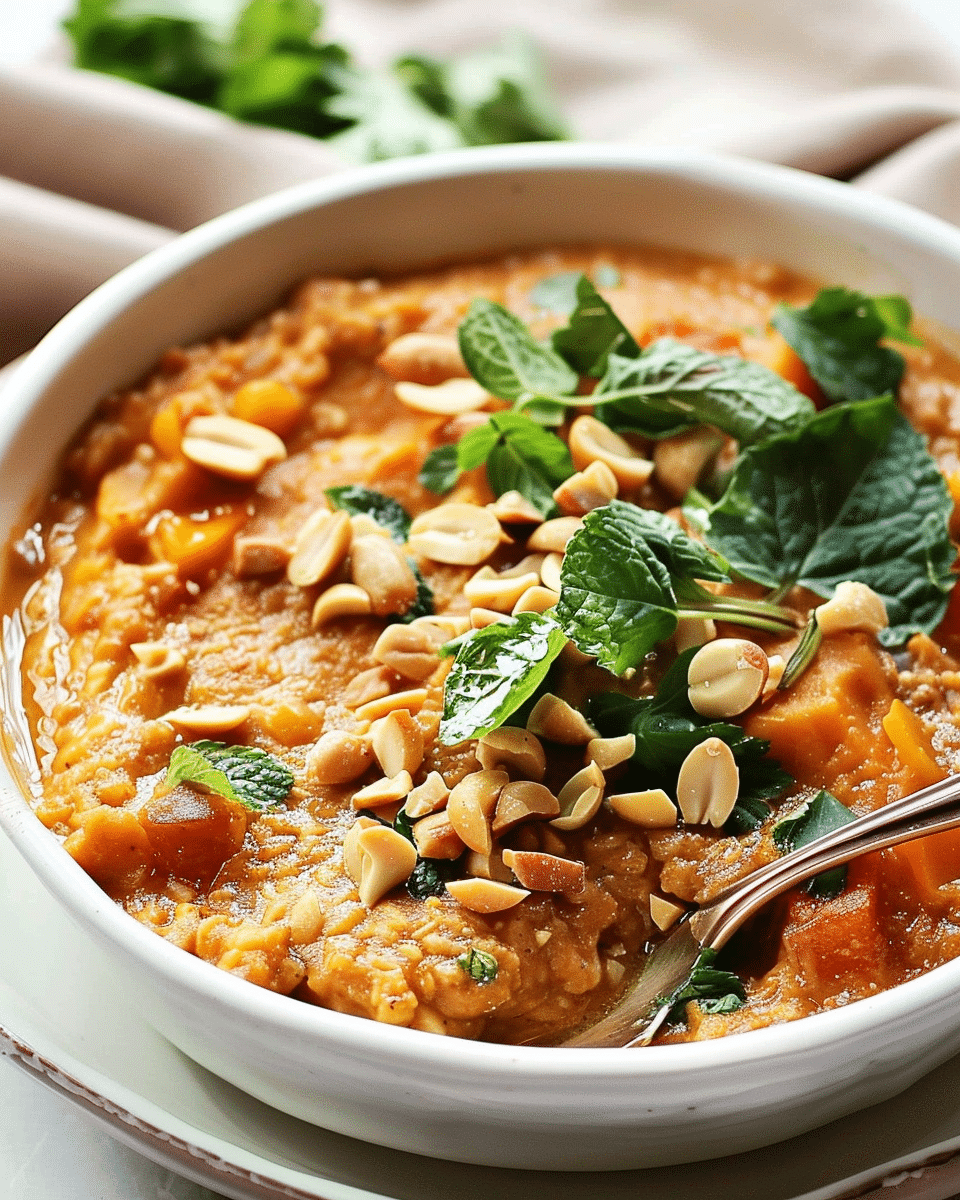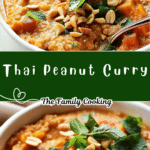Why You’ll Love This Recipe
This Thai Peanut Curry is a perfect combination of warmth and comfort, with the depth of peanut butter adding creaminess and a unique flavor profile. Whether you’re a vegetarian, vegan, or meat lover, this curry has versatile options that cater to all diets. The hearty mix of veggies, protein, and spices make it not only a flavorful meal but a nutritious one as well. Plus, the coconut milk gives the dish a smooth texture that blends beautifully with the rich peanut flavor.
Ingredients
-
1 tablespoon coconut oil
-
1 onion, chopped
-
2 garlic cloves, minced
-
1 tablespoon ginger, grated
-
1 red bell pepper, sliced
-
1 zucchini, chopped
-
1 cup broccoli florets
-
1 carrot, sliced
-
1 cup coconut milk
-
1/2 cup peanut butter
-
2 tablespoons soy sauce
-
1 tablespoon maple syrup or honey
-
1 tablespoon rice vinegar
-
1 teaspoon red curry paste
-
1/2 teaspoon turmeric
-
1/2 teaspoon chili flakes (optional for heat)
-
Salt and pepper, to taste
-
1 pound chicken breast, tofu, or shrimp (optional, can be omitted for a vegetarian version)
-
1/4 cup fresh cilantro, chopped (for garnish)
-
1 tablespoon lime juice (for garnish)
(Tip: You’ll find the full list of ingredients and measurements in the recipe card below.)
Directions
-
In a large skillet or saucepan, heat the coconut oil over medium heat.
-
Add the chopped onion, and sauté until softened and translucent, about 3-4 minutes.
-
Stir in the garlic and ginger, and cook for another minute until fragrant.
-
Add the red bell pepper, zucchini, broccoli, and carrot to the pan. Sauté the vegetables for 5-7 minutes until they begin to soften.
-
If you’re adding protein (chicken, tofu, or shrimp), add it to the pan and cook until fully cooked through.
-
In a small bowl, whisk together the coconut milk, peanut butter, soy sauce, maple syrup (or honey), rice vinegar, red curry paste, turmeric, chili flakes, and a pinch of salt and pepper.
-
Pour the peanut sauce over the cooked vegetables and protein. Stir to combine, making sure everything is evenly coated.
-
Let the curry simmer for another 5-7 minutes, allowing the flavors to meld together and the sauce to thicken.
-
Remove from heat and stir in lime juice and cilantro before serving.
Servings and Timing
-
Servings: 4-6
-
Preparation Time: 10 minutes
-
Cooking Time: 25 minutes
-
Total Time: 35 minutes
Variations
-
Vegan: Skip the chicken or shrimp, and use tofu or tempeh for a protein-packed vegan version.
-
Noodles: Serve the curry over rice noodles for a more filling dish.
-
Spicy: Add extra chili flakes or a sliced fresh chili for more heat.
-
Vegetables: Feel free to swap out or add other vegetables like mushrooms, eggplant, or snap peas.
-
Nut-Free: If you’re allergic to peanuts, you can substitute the peanut butter with almond butter or sunflower seed butter.
Storage/Reheating
-
Storage: Store any leftover curry in an airtight container in the refrigerator for up to 3-4 days.
-
Freezing: This curry can be frozen in a sealed container for up to 2-3 months. To reheat, defrost in the fridge overnight before warming it on the stove.
-
Reheating: Reheat the curry on the stovetop over low heat, stirring occasionally. Add a little water or coconut milk if the sauce thickens too much during storage.
FAQs
Can I make this curry ahead of time?
Yes, you can make the curry ahead of time and store it in the refrigerator for 3-4 days. It actually tastes even better after the flavors have had time to meld.
What protein can I use in Thai Peanut Curry?
You can use chicken, shrimp, tofu, tempeh, or even beans for a vegetarian option. It’s versatile and can be customized based on your preference.
Can I use a different nut butter for the curry?
Yes, you can use almond butter or cashew butter as a substitute for peanut butter if you have an allergy or preference for other nut flavors.
Is this Thai Peanut Curry spicy?
The level of spiciness can be adjusted to your liking. You can add more chili flakes or fresh chili for extra heat, or omit them for a milder flavor.
Can I use canned vegetables in this curry?
Fresh vegetables are recommended for the best flavor and texture, but you can use canned vegetables if that’s what you have on hand. Just be sure to drain and rinse them before adding to the curry.
How can I make this curry more flavorful?
If you want to elevate the flavor, try adding some lime zest or fish sauce to the sauce. Fresh herbs like basil or cilantro can also enhance the taste.
What do I serve this curry with?
This curry pairs beautifully with jasmine rice, brown rice, or rice noodles. You can also serve it with a side of steamed vegetables or a light salad.
Is this recipe gluten-free?
Yes, this recipe is naturally gluten-free as long as you use tamari or a gluten-free soy sauce substitute.
Can I make this curry spicier?
Absolutely! Add more chili flakes, fresh chilies, or even a dash of Sriracha to bring more heat to the dish.
How do I know when my protein is cooked through?
Chicken should be cooked to an internal temperature of 165°F (74°C), shrimp should be pink and opaque, and tofu should be golden and crispy on the outside. Always check the internal temperature or color for a sign that your protein is cooked.
Conclusion
Thai Peanut Curry is a delicious and comforting dish that’s easy to make and full of flavor. It’s versatile enough to cater to different dietary preferences and can be customized to your taste. Whether you make it for a quick weeknight dinner or a special gathering, this recipe will surely become a favorite in your kitchen.
PrintThai Peanut Curry
This creamy Thai Peanut Curry combines savory, spicy, and sweet flavors in a rich peanut sauce. Made with fresh vegetables, tender proteins, and a coconut milk base, it’s a comforting and flavorful dish that’s perfect for weeknight dinners or impressing guests. Whether you prefer chicken, tofu, shrimp, or a vegan option, this curry is versatile, easy to prepare, and packed with vibrant flavors.
- Prep Time: 10min
- Cook Time: 25min
- Total Time: 35min
- Yield: 4-6servings
- Category: Main Course
- Method: Stovetop
- Cuisine: Thai
- Diet: Gluten Free
Ingredients
1 tablespoon coconut oil
1 onion, chopped
2 garlic cloves, minced
1 tablespoon ginger, grated
1 red bell pepper, sliced
1 zucchini, chopped
1 cup broccoli florets
1 carrot, sliced
1 cup coconut milk
1/2 cup peanut butter
2 tablespoons soy sauce
1 tablespoon maple syrup or honey
1 tablespoon rice vinegar
1 teaspoon red curry paste
1/2 teaspoon turmeric
1/2 teaspoon chili flakes (optional for heat)
Salt and pepper, to taste
1 pound chicken breast, tofu, or shrimp (optional, can be omitted for a vegetarian version)
1/4 cup fresh cilantro, chopped (for garnish)
1 tablespoon lime juice (for garnish)
Instructions
-
Heat coconut oil in a large skillet or saucepan over medium heat.
-
Add chopped onion and sauté until softened and translucent, about 3-4 minutes.
-
Stir in garlic and grated ginger, cooking for an additional minute until fragrant.
-
Add red bell pepper, zucchini, broccoli, and carrot to the pan. Sauté for 5-7 minutes until vegetables soften.
-
If using protein (chicken, tofu, or shrimp), add it to the pan and cook until fully cooked.
-
In a small bowl, whisk together coconut milk, peanut butter, soy sauce, maple syrup (or honey), rice vinegar, red curry paste, turmeric, chili flakes, salt, and pepper.
-
Pour the peanut sauce over the vegetables and protein. Stir to coat everything evenly.
-
Let curry simmer for another 5-7 minutes, allowing the flavors to meld and the sauce to thicken.
-
Remove from heat and stir in lime juice and fresh cilantro before serving.
Notes
-
Vegan Option: Omit the chicken or shrimp and use tofu or tempeh for a protein-packed vegan version.
-
Spicy: For extra heat, add more chili flakes or a fresh chili.
-
Noodles: Serve over rice noodles for a more filling meal.
-
Nut-Free: Substitute peanut butter with almond butter or sunflower seed butter if you’re allergic to peanut



